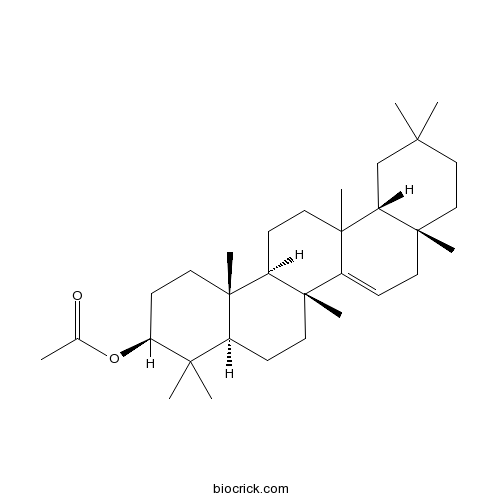Nouelia insignis
Nouelia insignis
1. The products in our compound library are selected from thousands of unique natural products; 2. It has the characteristics of diverse structure, diverse sources and wide coverage of activities; 3. Provide information on the activity of products from major journals, patents and research reports around the world, providing theoretical direction and research basis for further research and screening; 4. Free combination according to the type, source, target and disease of natural product; 5. The compound powder is placed in a covered tube and then discharged into a 10 x 10 cryostat; 6. Transport in ice pack or dry ice pack. Please store it at -20 °C as soon as possible after receiving the product, and use it as soon as possible after opening.
Natural products/compounds from Nouelia insignis
- Cat.No. Product Name CAS Number COA
-
BCN4937
Taraxeryl acetate2189-80-2
Instructions

LC-MS guided isolation of ent-kaurane diterpenoids from Nouelia insignis.[Pubmed: 27094114]
The preliminary LC-MS investigation on the stems of Nouelia insignis manifested the existence of diterpenoids. As a result, 15 ent-kaurane diterpenoids, including 7 new glycosides (nouelosides A-G, 1-7), were isolated under the direction of LC-MS analysis. The new compounds were determined by extensive spectroscopic analysis including HRESIMS, 1D and 2D NMR data and chemical methods. Compounds 6 and 15 with the exo-methylene cyclopentanone functional group exhibited obvious nitric oxide production inhibitory activity with IC50 values of 3.84±0.20 and 3.19±0.25μM.
Genetic divergence and phylogeographic history of two closely related species (Leucomeris decora and Nouelia insignis) across the 'Tanaka Line' in Southwest China.[Pubmed: 26153437]
Leucomeris decora and Nouelia insignis (Asteraceae) are narrowly and allopatrically distributed species, separated by the important biogeographic boundary Tanaka Line in Southwest China. Previous morphological, cytogenetic and molecular studies suggested that L. decora is sister to N. insignis. However, it is less clear how the two species diverged, whether in full isolation or occurring gene flow across the Tanaka Line. Here, we performed a molecular study at the population level to characterize genetic differentiation and decipher phylogeographic history in two closely related species based on variation examined in plastid and nuclear DNAs using a coalescent-based approach.
Population structure of Nouelia insignis (Asteraceae), an endangered species in southwestern China, based on chloroplast DNA sequences: recent demographic shrinking.[Pubmed: 20585828]
Nouelia insignis, an endangered species, is distributed in the Jinsha and Nanpan drainage areas in southwestern China. In this study, we examined the genetic diversity and population structure based on the sequences of the cpDNA rpL 16 intron. Low levels of genetic variation were detected within all populations of the endemic species. A gene genealogy of 11 haplotypes recovered two major lineages I and II, with haplotypes H1 and H6 nested as interior nodes, respectively. Haplotype H1 was widespread in all populations, while haplotype H6 was restricted to populations southern of the Jinsha River. Low levels of genetic differentiation were detected, as most F (st) values between populations were zero. This result, however, contradicts previous studies based on allozymes and fingerprinting. Genetic analyses suggested that coancestry due to low evolutionary rates resulted in the lack of geographical subdivision. Molecular dating estimated that the two lineages split about 3.224 MYA (95% CI 1.070-6.089 MYA). Maintenance of ancestral polymorphisms was possibly attributable to a long-standing large effective population size until recently. Postglacial demographic expansion was supported by a unimodal mismatch distribution and star-like phylogenies.
Chemical constituents of Nouelia insignis Franch.[Pubmed: 18253880]
Two new diterpenes and ent-15alpha-hydroxykaur-16-en-19-oic acid 11,12-acetonide (3), together with 23 known compounds were isolated from the dried aerial parts of Nouelia insignis Franch. The structures of new compounds were determined to be ent-14beta,15alpha-dihydroxykaur-16-en-19-oic acid (1), ent-14beta-hydroxy-15-oxokaur-16-en-19-oic acid (2) on the basis of spectral and chemical evidence. The structure of ent-11alpha,16alpha-epoxy-15alpha-hydroxy-16S-kaur-19-oic acid (4) was confirmed by X-ray crystallographic analysis.
High genetic diversity vs. low genetic differentiation in Nouelia insignis (Asteraceae), a narrowly distributed and endemic species in China, revealed by ISSR fingerprinting.[Pubmed: 16807255]
Nouelia insignis Franch., a monotypic genus of the Asteraceae, is an endangered species endemic in Yunnan and Sichuan Provinces of China. Most of the populations are seriously threatened. Some of them are even at the brink of extinction. In this study, the genetic diversity and differentiation between populations of this species were examined in two drainage areas.


